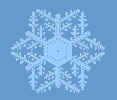

We also have a non-technical discussion of the high Tc leads in our Introduction to Cryogenics section.
The material of the leads is Ytterbium-Barium-Copper-Oxide, Y1Ba2Cu3O7, (YBCO).
Illinois Superconductor Corporation produced the 25 cm long YBCO filaments used in the leads. Because of the fragility of YBCO, the filaments need mechanical support. Therefore, Goddard technicians epoxy the filaments to thin-walled fiberglass tubes. The tubes are 10 inches (25 cm) long and1/4 inch (.64 cm) in diameter. Loops of Kevlar 49 yarn, running down the centers of the tubes, hold the tubes in place. The Kevlar does not touch the fiberglass tubes; it runs through holes in disks which fit inside the tubes.
Both ends of the YBCO filaments are coated with silver, which is baked in. Indium solder connects lead wires to the ends of the filaments: copper leads at the "warm" end, and copper-clad niobium-titanium (NbTi) superconducting leads at the "cold" end. The superconducting wires are heat sunk to the dewar before connecting to the magnet or valves. A copper braid heat sinks the "cold" ends of the fiberglass tube assemblies to a 4 Kelvin stage.
Here is a simplified diagram of the YBCO lead assembly, showing the fiberglass tube with 3 YBCO leads on it (out of the 12 leads on a real assembly.) The diagram does not show the fiberglass disk spacers which keep the Kevlar strand centered in the fiberglass tube, because the disks are inside the tube, and are thus hidden in this view.All filaments are tested in a liquid helium dewar at 4.2 Kelvin with currents of 1, 2, and 3 amps.
The XRS Cryogenics Team tested the thermal characteristics of each lead assembly in a liquid helium dewar modified to produce the temperatures present in the XRS flight dewar. The support for the lead is a temperature controlled stage which can be held at 17 Kelvin, the temperature of the solid neon tank. The copper braid used to heat sink the lead's "cold" end runs to another stage, whose temperature is allowed to float above the dewar's 4.2 Kelvin cold plate. Heat flowing along the copper braid into the floating stage gives a good measure of the heat that will be conducted by the braid to the 4 Kelvin heat stage in the XRS flight dewar. Predicted heat loads in the flight dewar are less than 250 microwatts per assembly.
Flight and prototype assemblies were vibration tested at room temperature. The vibration loads simulated the launch loads of the Japanese M-V rocket, which will launch the XRS instrument. After the vibration tests, both flight assemblies again passed critical current tests at 4.2 Kelvin.
Next: Part 3: The Magnesium Diboride Leads
"A High Tc Superconducting Current Lead Assembly for the the XDS Helium Cryostat", J.G. Tuttle, T.P. Hait, R.F. Boyle, H.J. Muller, J.D. Hodge, and S.R. Breon, Advances in Cryogenic Engineering 43, ed. P. Kittel, p. 965-972 (1998). Abstract
"Astro-E2 Magnesium Diboride High Current Leads", J.S. Panek, J.G. Tuttle, V. Marrero, S. Mustafi, R. Edmonds, A. Gray, S. Riall, Advances in Cryogenic Engineering 49, ed. J. Waynert et al., p. 952-957.
General Links
 Cryogenics & Fluids Home Page
Cryogenics & Fluids Home Page
|

|